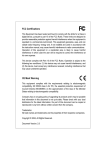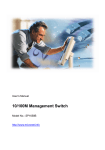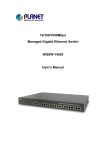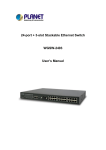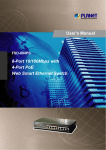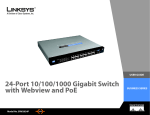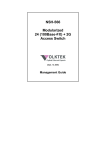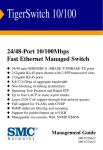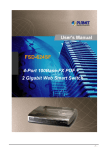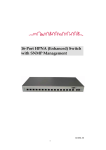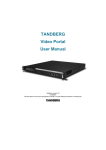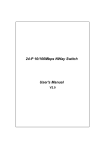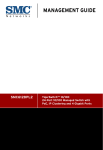Download FCC Certifications CE Mark Warning
Transcript
FCC Certifications This Equipment has been tested and found to comply with the limits for a Class A digital device, pursuant to part 15 of the FCC Rules. These limits are designed to provide reasonable protection against harmful interference when the equipment is operated in a commercial environment. This equipment generates, uses, and can radiate radio frequency energy and, if not installed and used in accordance with the instruction manual, may cause harmful interference to radio communications. Operation of this equipment in a residential area is likely to cause harmful interference in which case the user will be required to correct the interference at his own expense. This device complies with Part 15 of the FCC Rules. Operation is subject to the following two conditions: (1) this device may not cause harmful interference, and (2) this device must accept any interference received; including interference that may cause undesired operation. CE Mark Warning This equipment complies with the requirements relating to electromagnetic compatibility, EN 55022 class A for ITE, the essential protection requirement of Council Directive 89/336/EEC on the approximation of the laws of the Member States relating to electromagnetic compatibility. Company has an on-going policy of upgrading its products and it may be possible that information in this document is not up-to-date. Please check with your local distributors for the latest information. No part of this document can be copied or reproduced in any form without written consent from the company. Trademarks: All trade names and trademarks are the properties of their respective companies. Copyright © 2002, All Rights Reserved. Document Version: 2.0 1 Table of Contents 1. Overview 2. Unpacking Information 3. Introduction to 24F.E.+2G.E. Gigabit Clustering Switch 3.1 General Description 3.2 Key Features 3.3 The Front Panel Port Operation Wiring for 10/100Mbps (Fiber Optical/Copper) LEDs Definition Power LED RTC LED STATUS 0 LED STATUS 1 LED Port LEDs (10/100Mbps Copper/Fiber Optical) SPD/LINK/ACT LED FULL/COL LED LINK/ACT LEDs (For slide-in slots on the rear panel) LINK LED (“STACK” port) HUB ID RESET button 3.4 The Rear Panel Gigabit Slide-in slots Gigabit Module Operation Wiring for Gigabit Slide-in Module Console Port Power Receptacle 2 4. Installing 24F.E.+2G.E. Gigabit Clustering Switch 4.1 Desktop Installation 4.2 Rack-mount Installation 4.3 Installing Network Cables Station Connections Switch-to-Switch Connections 4.4 Module Installation 4.5 Management Stack 4.6 Network Application 5. Management Guide 5.1 Console Port (Out-of-Band) connection 5.2 In-Band Connections (Web Browser/ Telnet) Starting a Telnet Session Starting a Web Browser Session Topology System Configuration Device Panel Display Port Status Network Configuration Device Information Topology Info Ports Information Configuration Setup Port Attributes Duplicate Port Attributes Statistic Location Search VLAN 802.1Q VLAN VLAN Static List To create a new VLAN group To remove a VLAN group 3 To modify a VLAN group VLAN Static Table To add member port To remove member port VLAN Port Configuration To change the PVID Port Group VLAN All Together All Independent Port Aggregation Priority Address Table MAC Address list Configuration To add a static address To remove a static address Mirror 6. Product Specifications 4 1. Overview The Gigabit Managed Cluster is a powerful, high-performance, high port-density networking system, which can upgrade and integrate your existing network from 10/100Mbps to a simplex, efficient, centralized management environment and very high-speed network architecture. As all members operate as teamwork, all connected members of the family are treated as a Single-Managed device. With its built-in rich, various and advanced management functions, system administrator can monitor and control the whole system or individual port of any members easily and remotely. The members of the Gigabit Managed Cluster are: 24F.E.+2G.E Gigabit Clustering Switch 14+2G.E. Gigabit Clustering Switch 16V+2G.E. VDSL Clustering Switch 5 6 2. Unpacking Information Thank you for purchasing the 24F.E.+2G.E. Gigabit Clustering Switch. Before you start, please check all the contents of this package. The product package should include the following: 1. One 24F.E.+2G.E. Gigabit Clustering Switch 2. One power cord 3. Rubber foot and screws 4. Rack-mount brackets 5. User’s Manual 7 3. Introduction to 24F.E.+2G.E. Gigabit Clustering Switch 3.1 General Description The device is a 24+2-port 10/100/Gigabit Ethernet clustering switch with twenty-four 10/100Mbps RJ-45 ports and two Gigabit slide-in slots on the rear panel for optional fiber/copper Gigabit modules. Compare to the traditional 10/100Mbps Ethernet, the switch delivers a dedicated 10/100Mbps connection to every attached client with no congestion issue. The gigabit ports also provide the fat pipe to the server or backbone connectivity for boosting the total system performance. Moreover, the NWay auto-negotiation operation automatically negotiates with the connected partners on the network speed and duplex mode; that provides an easy way to integrate 10 / 100 / 1000Mbps networks with no pain. It is ideal for micro-segmenting large networks into smaller, connected subnets for improved performance, enabling the bandwidth demanding multimedia and imaging applications. Out of the ordinary dumb switches, the 24F.E.+2G.E. Gigabit Clustering Switch embedded advanced management capability; that the device can be remote managed by Telnet, SNMP manager and Internet browser. This is much useful for system manager to monitor and control the system efficiently. Store-and-forward switching mode promises the low latency plus eliminates all the network errors, including runt and CRC error packets. To work under full-duplex mode, transmission and reception of the frames can occur simultaneously without causing collisions as well as double the network bandwidth. The switch is plug-n-play without any software to configure and also fully compliant with all kinds of network protocols. Moreover, the rich diagnostic LEDs on the front-panel provide the operating status of individual port and whole system. 8 3.2 Key Features Complies IEEE 802.3, IEEE 802.3u, IEEE802.3x, IEEE 802.3z/ab standards Complies with IEEE802.1Q VLAN tag (IVL) Complies with IEEE802.1p CoS with 2-level priority The whole management stack can stack up to 8 sets 24 * RJ-45 ports for 10/100Mbps 2 * 1000Mbps Copper/Fiber slide-in slots 1 * 100Mbps Fiber slot (Alternative to copper port-1) Proprietary management bus extend up to 800 meters for management stacking Every switching port is automatically cross-over detection (MDI/ MDI-X auto-detected) Supports real-time clock (optional) Supports IGMP snooping Supports MIB counters Supports port sniffering Supports Port Aggregation and up to 7 groups Supports port group VLAN and up to 255 groups Supports 802.1Q VLAN and up to 255 groups Supports 802.1D Spanning Tree One RS-232 female console connector Supports 8MB SDRAM for run time data storage Supports 2MB Flash EPROM for cooperation and configuration data storage Supports 6K MAC entries Supports 3Mbit packet switching 19” rack mountable Internal universal switching power supply FCC Class A, CE 9 3.3 The Front Panel The front panel of the switch is shown as below Port Operation There are 24 * 10/100Mbps RJ-45 (copper) ports with 1 * 10/100Mbps fiber optical slide-in slot (Alternative to copper port-1). --10/100Mbps Fiber SC The auto-negotiation feature of the switch allows each port of the device running at one of the following operation modes: Port Media Speed 10/100Mbps 10/100Mbps fiber optical SC (Alternative to copper port-1) Duplex Mode 10Mbps Full Duplex Half Duplex 100Mbps Full Duplex Half Duplex 10/100Mbps RJ-45 (copper) 10Mbps Full Duplex Half Duplex 100Mbps Full Duplex Half Duplex All copper ports supports MDI/MDI-X auto crossover capability that is the port can connect either the PC or hub without crossover cable adjustment. 10 Wiring for 10/100Mbps (Fiber Optical/Copper) Following are the summaries of cabling required: Media Speed 10/100Mbps copper 10Mbps 10/100Mbps Fiber SC Wiring Category 3,4,5 UTP/STP 100Mbps Category 5 UTP/STP 10/100Mbps 62.5/125 or 50/125µm multi-mode fiber optic Attention:1. Category 5 cable is preferred to use with this product in structured wiring environments. This will ensure correct operation of RJ-45 ports at 10Mbps, 100Mbps or 1000Mbps. 2. The proprietary management bus (“STACK” RJ-45 ports) on the front panel is reserved for management stacking, only straight-through UTP/STP cable can be used. There is no Duplex Mode issue and the extended distance can up to 800 meters. 11 LEDs Definition The rich diagnostic LEDs on the front panel can provide the operating status of individual port and whole system. Power LED This indicator lights green when the switch is receiving power; otherwise, it is off. RTC LED When standalone using the switch, this indicator indicates the optional Real Time Clock is functioning or not. If it does, the RTC LED lights green. In the management stack, the RTC LED blinks green to indicate management bus activity STATUS 0 LED When this LED steady green, it means the device acts competent leading role, an indispensable essential for system administrator to control and monitor whole system. At the time one member of the cluster disconnected or new member joined, the “STATUS 0” LED blinks. Soon, one and only one master will be raised. You can reference to “HUB ID” for relative information in the next. STATUS 1 LED The “STATUS 1” LED flashes green when Run Time Error occurs. Port LEDs (10/100Mbps Copper/Fiber) Every 10/100Mbps port relevant two LEDs (SPD/LINK/ACT; FULL/COL) for indicating the speed and connection status. SPD/LINK/ACT LED SPD/LINK/ACT LED Status Off No Connection Green Connected as 100Mbps Flashing Green There is traffic transverses the port Amber Connected as 10Mbps Flashing Amber There is traffic transverses the port 12 If the port is connected but the SPD/LINK/ACT LED is dark, check the following items: 1. The switch and the connected device’s power are on or not. 2. The connecting cable is good and with correct type 3. The cable is firmly seated in its connectors in the switch and in the associated device 4. The connecting device, including any network adapter is well installed and functioning FULL/COL LED A collision occurs when two stations within a collision domain attempt to transmit data at the same time. Intermittent flashing amber of the collision LED is normal; the contending adapters resolve each collision by means of a wait-then-retransmit algorithm. Frequency of collisions is an indicator of heavy traffic on the network. If the FULL/COL LED lights amber, means the port is under Full-Duplex operation or dark for Half-Duplex mode. FULL/COL LED Status Steady Amber Full-Duplex mode Dark Half-Duplex mode Flashing Amber Collision Attention:The 10/100Mbps fiber optical SC slot shares with copper port-1 in the same LED indicators 13 LINK/ACT LEDs (For slide-in slots on the rear panel) The slide-in slot has a LINK/ACT LED itself. When one slide-in module is well installed and functioning, the relevant one lights green. LINK LED (“STACK” port) The LED lights green, when a management stack is made via the “STACK” port and negotiates with associated devices successfully. HUB ID(Rotary Switch) All members of the management stack are ranked according to their “HUB ID”(Device ID). There are eight degrees (0~7) in the rotary switch. The smaller number, the higher degree. Device with smallest “HUB ID” will be the “Master” device. Then, system management can perform by the way of the “Master Device”. Attention:Every device in the management stack should have a unique “HUB ID”. In the meanwhile, a “HUB ID” which has been using by a device, reused by another, the management stack will fail. RESET Button The system will reboot when “RESET” button is pressed. 14 3.4 The Rear Panel The rear panel of the switch is shown as below Gigabit Slide-in slots The two slide-in slots on the rear panel are reserved for following optional gigabit modules. They can provide fat pipes for up linking to backbone or connecting to servers. --Gigabit Fiber SC --Gigabit Copper Gigabit Module Operation Port Media Speed Duplex Mode Gigabit port Gigabit RJ-45 port 10Mbps Full Duplex Half Duplex 100Mbps Full Duplex Half Duplex 1000Mbps Full Duplex Gigabit Fiber SC 1000Mbps Full Duplex 15 Wiring for Gigabit Slide-in Module Following are the summaries of cabling required: Media Speed Wiring Gigabit copper 10Mbps Category 3,4,5 UTP/STP 100Mbps Category 5 UTP/STP 1000Mbps Category 5 UTP/STP 1000Mbps 62.5/125 or 50/125µm multi-mode fiber optic Gigabit Fiber SC Console Port The RS-232 console is an interface for connecting a terminal directly. Through the console port, it provides rich diagnostic information includes network statistics, link status and system setting. The operating mode of the console port is: DCE 9600 (Fix baud rate) n (No parity checking) 8 (8 Data bits) 1 (1 stop bit) None (No flow control) You can use a normal RS-232 cable and connect to the console port on the device. After the connection, you can run any terminal emulation program (Hyper Terminal, Winterm, Telix, … and so on) to enter the startup screen of the device. All the detail software operation, please refer to “Console port (out-of-band) connection” session of chapter 5. 16 Power Receptacle For compatibility with electric service in most areas of the world, the switch’s power supply automatically adjusts to line power in the range 100-240 VAC and 50-60 Hz. Plug the female end of the power cord firmly into the receptacle on the rear panel of the switch. Plug the other end of the power cord into an electric service outlet then the power will be ready. 17 4. Installing 24F.E.+2G.E. Gigabit Clustering Switch This switch can be placed directly on your desktop, or mounted in a rack. If you install the device in a normal-standalone standard, the switch is an Intelligent Switch, and users can immediately use most of the features simply by attaching the cables and turning the power on. In this case, any managerial proceedings are effective only in the range of the switch. After management stacking, you can enjoy the powerful management functions and control the whole system. 4.1 Desktop Installation For desktop installation, the switch needs to put on a clean, flat desk or table close to a power outlet. Plug in all network cables and the power cord, then the system is ready. Before installing the switch, you must ensure: 1. 2. 3. 4. It is accessible and cables can be connected easily Cabling is away from: *Sources of electrical noise such as radios, transmitters and broadband amplifiers *Power lines and fluorescent lighting fixtures. Keep water or moisture off Airflow around the unit and through the vents in the side of the case is great for heat radiation (company recommend that you provide a minimum of 25 mm clearance) To prolong the operational life of your units: 1. 2. 3. Never stack unit more than eight sets high if freestanding Do not place objects on top of any unit or stack Do not obstruct any vents at the sides of the case 18 4.2 Rack-mount Installation The switch may standalone, or may be mounted in a standard 19-inch equipment rack. Rack mounting produces an orderly installation when you have a number of related network devices. The switch is supplied with rack mounting brackets and screws. These are used for rack mounting the unit. Rack Mounting the Switch in the 19-inch rack: 1. 2. 3. 4. 5. 6. 7. Disconnect all cables from the switch before continuing. Place the unit the right way up on a hard, flat surface with the front facing toward you. Locate a mounting bracket over the mounting holes on one side of the unit. Insert the screws and fully tighten with a suitable screwdriver. Repeat the two previous steps for the other side of the unit. Insert the unit into the 19" rack and secure with suitable screws (not provided). Reconnect all cables. 19 4.3 Installing Network Cables After placing the switch on the desktop, we need to know how to connect the device to network. Station Connections Reference to the wiring statement of the previous section; connect each station to the switch with correct type of cables. Switch-to-Switch Connections In making a switch-to-switch connection, use Gigabit ports to connect another switch or backbone is strongly recommended. The Gigabit ports provide the fat pipe to the server or backbone connectivity for boosting the total system performance. Reference to the wiring statement of the previous section; connect each station to the switch with correct type of cables. Furthermore, as the switch supports port aggregation (port-trunk) capability and up to 7 groups, it is also great to build up switch-to-switch connectivity. For detail information, please reference to the “Management Guide” session. 4.4 Module Installation The three slide-in slots on the front and rear panel are purposed for installing optional modules. They can be used as a network backbone or connect to a server. Follow the steps as described to install a module: 1. 2. 3. 4. Power off the switch Removing the two screws on the face plate of slide-in slot with a flat-head screwdriver Push the module gently into the slot along the slide tracks Ensuring that it firmly engages with the connector then tighten the screws to secure the module Attention:The slide-in slots are not hot swappable, power off the switch before installing modules 20 4.5 Management Stack There are two RJ-45 ports on the front panel for proprietary management stack. Only straight-through UTP/STP cable can be used. Plug one end of the cable in the “IN” port and the other end to the ”OUT” port of next device. Repeat the step for every device in the cluster, then ending at last switch. Attention:Before management stacking, be sure of every device uses a unique “HUB ID”, or the management stack will not work 21 4.6 Network Application 22 5. Management Guide This section instructs you how to enter and proceed the advanced management capability, which can be accessed by RS-232 serial port (out-of-band) on the rear panel or by Telnet session / Internet Browser over the network (in-band). The management functions such as: · · · · · Port Information/configuration/Statistic/Location Search/Duplex mode/Flow Control SNMP parameters 802.1Q/Port Group VLAN Upgrade system firmware Reboot system 5.1 Console Port (Out-of-band) connection After attaching a RS-232 cable (Straight-through) to the serial port of a PC running a terminal emulation program, press “Enter” key then login screen appears. Enter your username and password to login the management console. Note: The management functions of console program are exactly the same with web-based management interface but in text mode. For further operation, please refer to ’Starting a Web Browser Session’. Attention:1. The factory default value of UserName and Password is “admin” 2. For detail console port configurations, please refer to “Console Port” in chapter 3 3. System configurations via the Console Port only will be allowed by the way of master device 23 5.2 In-Band Connections (Web Browser / Telnet) To manage the switch through in-band access, you should configure the management station with an IP address and subnet mask compatible with your clustering switch. Factory Default value: 10.0.0.1 IP: Subnet Mask: 255.0.0.0 Default Gateway: 10.0.0.254 Both standalone switch and the cluster can be managed using either a standard Web Browser or a Telnet session from any computer attached to the network. The SNMP management feature also permits the switch to be managed from any SNMP network management station running a network management program. To manage the Standalone switch: Access the switch with its IP address “10.0.0.1” (factory default value) To manage any of the Clustering switch: Access the switch with the IP address of Master device in the management stack. Then select the switch you want to manage in the first page Starting a Telnet Session To access the switch through a Telnet session: 1. Sure of the switch is configured with an IP address and the switch is reachable from a PC 2. Start the Telnet program on a PC and connect to the switch Note: The management functions of Telnet program are exactly the same with web-based management interface but in text mode. For further operation, please refer to ’Starting a Web Browser Session’. 24 Starting a Web Browser Session This Web Browser User Interface is coded by Java Applet and running on the JavaTM Virtual Machine (JVM) version 1.3.1 platform. You should configure the management station with an IP address and subnet mask compatible with your clustering switch for accessing it. Also, the management station should be well configured and connected to Internet for automatically downloading (upgrading) the suitable JVM through Internet from “http://java.sun.com”. Or you can download it yourself by the URL “http://java.sun.com/j2se/1.3/download.html” and then manually install it. Attention:Occasionally the newer JavaTM Virtual Machine is not backward compatible, that JVM version 1.3.1 is strongly recommended to ensure properly operation Running your Web Browser and enter the IP address “10.0.0.1” (When your switches are in a well-installed management stack, remember that the portal IP address will be vary with your actually management topology) as the URL in the “address” field. After authentication procedure, the home page shows up. In this page, you can view the management stack topology or standalone switch. 25 Topology This screen displays one or more switches of the management stack. Basic properties can be read by the screen, include Hardware characteristic, Device Name, Device Up time, Master and Slave relationship. Also, by mouse clicking listed items can enter for further operation. System Configuration If you are managing a Master or a Standalone device, the system configuration parameters are equal to parameters of Net Configuration and Device Information in Device tab. For further information, please refer to Device statement. 26 After clicking the 24F.E.+2G.E. Gigabit Clustering Switch, main screen shows up. Function Statement <Home> Shortcut to back to home page <Save> Save the current setting to Non-volatile Memory. The difference between <Save> and <Apply> is that Apply applies settings right away but saves the values in the system memory. Every time when switch reboots, system obtains system parameters from Non-volatile Memory you <Saved> before but not buffer memory. Select the one(s) you want to save parameters, then click “Save” button to save it to Non-volatile Memory. <Default> Make the switch(es) returning to factory default value. Select the switch and click “Default” button, the selected-switch(es) will return to initial value. If you want to clear the previous value in the Non-volatile Memory, please <Save> it. 27 <Reboot> You can specify switch(es) and reboot it. Warm Boot Reboot the switch in a short time. Cold Boot Boot the switch and with fully Power On Self Test (POST). The system is completely checked but spend much time. <Ping> The Ping is a commonly used tool to detect the remote host or IP address exists or not. Moreover, network status also can be known by the ratio of packets Reply and Loss. <Telnet> By simply clicking the <Telnet> button, the Telnet program implements and displays login screen. <Contact> Contact technicians for technical support by E-Mail 28 <Upgrade> WEB Upload 1. Select Device ID and “WEB Upload” radio button then click OK 2. Specify the file path by clicking Browse button and click Start TFTP Download 1. Select Device ID and “TFTP Download” radio button then click OK 2. Enter the TFTP server’s IP address in Server IP field 3. Enter file name in File Name field 4. Click Start button to download the code and system update with it automatically Local File Transfer 1. Select Device ID and “Local File Transfer” radio button then click OK 2. Click “Application” or ”Java Applet” radio button 29 3. The system starting software synchronization from Master Device (That the synchronized hardware should be identical to Master Device) Application --- System firmware Java Applet --- Web User Interface <Device:> The shortcut to go to another member switch in the management stack 30 Device Panel Display RTC LED HUB ID Status 0 LED Slide-in Modules Status 1 LED RJ-45 ports Port Status Port Link Down (Black) Port is not connected or attached device shuts down Port Link Up (Green) Port links up and working correctly Port Link Up (Amber) Port links up but in blocking mode Port Disabled (Red) Port has been disabled 31 Network Configuration IP Address IP address of this device Subnet Mask NetMask of your network Gateway IP IP address of Gateway Device Information Name Naming the system (optional) Contact Who the System administrator is (optional) Location Where the management stack locates (optional) Note: The Network Configuration and Device Information of Master Device in the management stack will become system parameters automatically. Topology Info This page displays information about the switch(es), such as Device ID, Hardware version, Boot-Up version, POST version, Runtime version (Firmware version), JAVA Applet version (Web User Interface version), Device Name and Device Location. When management stack persist, by the Device ID, all the members are transparently listed. 32 Ports Information It is a ports’ configurations summary table. Via the summary table, you can know status of each port clear at a glance, like Link Up/Link Down, Enable/Disable, Link Speed, Duplex mode and Flow Control. Note: Also by simply clicking the port on the ‘Panel Display’, the port information screen pops up 33 Configuration Port attributes can be setup in this page. Setup Port Attributes 1. 2. 3. 4. 5. 6. Click the “Name” column of the port. Enter a name for identification, like ‘Richard’; and press Enter Leave the “Admin” column ‘Enable’ value to make the port to be in operation or ’Disable’ to pause it Select Duplex mode---10Half/10Full; 100Half/100Full, ‘Auto’ for auto-negotiation and 1000Full auto-detection Select ‘Enable’ to take “Flow Control” effect Select the predefined “Bandwidth Control” scale (10%~100%) Click Apply button to apply settings Note: Also accomplished by simply mouse right-click the port on the ‘Panel Display’ then select ‘Configuration’, the configuration screen pops up 34 Flow Control operation mode: Speed / Duplex mode Flow Control 10Half Back pressure 100Half Back pressure 1000Half Back Pressure Speed / Duplex mode Flow Control 10Full IEEE 802.3x Pause Frame 100Full IEEE 802.3x Pause Frame 1000Full IEEE 802.3x Pause Frame 35 Duplicate Port Attributes Click “Duplicate” button, the dialogue screen appears. 1. 2. 3. 4. 5. 6. Select Source Port (for example Port 2) Select Target Port, click All for select all (for example Port 8, 9, 10) Select the port attributes you want to duplicate Click OK to submit values Click Apply button to apply settings As the following result, port 2 is duplicated to port 8, 9, 10 accompany with specified attributes. Note: Also accomplished by simply mouse right-click the port on the ‘Panel Display’ then select ‘Copy Setting’ to duplicate port properties and select ’Past Setting’ when point at destination port 36 Statistic Ether Like Frame Types RX Bytes RX Frames RX crc_err TX Byte TX Frames TX Collisions TX drops TX underruns Number of bytes received in good and bad frames Number of good and bad packets received Number of CRC errors received Number of bytes transmitted in good and bad frames Number of good and bad packets transmitted Number of collisions on transmitted frames Frames dropped due to lack of receive buffer Increments when packet transmission fails due to the inability of the interface to retrieve packets from the local packet buffer fast enough to transmit them onto the network RX Good Frame Types RX Bytes RX frames RX broadcasts RX multicasts RX less64_pkts RX 65to127_pkts RX 128to255_pkts RX 256to511_pkts RX 512to1023_pkts RX 1024more_pkts Number of bytes received in good and bad frames Number of good and bad packets received Number of good broadcasts Number of good multicasts Number of short frames with invalid CRC (<64 bytes) Number of 65 to 127-bytes frames in good and bad packets Number of 128 to 255-bytes frames in good and bad packets Number of 256 to 511-bytes frames in good and bad packets Number of 512 to 1023-bytes frames in good and bad packets Number of 1024 to max-length-type frames in good and bad packets 37 RX Error Frame Types RX alignment_err Number of alignment errors received RX crc_err Number of CRC errors received RX oversize_err Number of long frames with valid CRC RX undersize_err Number of short frames with valid CRC RX fragments_err Number of short frames with invalid CRC RX jabbers_err Number of long frames with invalid CRC Location Search A denominate port can be searched by its given name. (Match whole word only) 38 VLAN The VLAN is a group of ports that may spread around the network but communicate as though they belong to one subnet. By using IEEE 802.1Q compliant VLAN, all ports can be reorganized into separate broadcast domains for security reasons and reduce bandwidth occupation instead of using routers to divide whole network into subnets. It produces cleaner network environment by reducing broadcast traffic and simplify network management by allowing you to move devices to another VLAN without changing physical connections. 802.1Q VLAN Before enabling 802.1Q VLAN , pay attention to: · · All ports are default to VLAN 1 and assigned PVID 1 All the ports of a Aggregation Group must to be treated as an integer when added to/deleted from a VLAN VLAN Static List This screen is used to Add / Remove / Modify VLAN and up to 255 groups. The VLAN groups that have been created are all listed here. To create a new VLAN group 1. 2. 3. 4. Specify the name for the new VLAN group (VLAN name is only used for identification) Enter a number (VLAN ID) for the new VLAN group Check the “Active” box to activate the VLAN or leave it blank and activate it afterward Click <<Add button to create the new VLAN 39 To remove a VLAN group 1. 2. Select a VLAN group you want to remove from the “Current” list Click Remove>> button to remove it Attention:1. If a removed port is no longer belong to any other group, it is temporarily disabled because no one can communicate with it. 2. If one port’s PVID is equal to this VLAN ID, removing this VLAN group will not allow until you change it. To modify a VLAN group 1. 2. 3. Select a VLAN group you want to remove from the current list Modify parameters in “New” column Click Modify button to submit the new parameters VLAN Static Table This screen is used to Add/Remove member ports of a VLAN. Egress Ports/Member The ports that have been added to the displayed VLAN group Tagged Ports/Member The tagged ports of the displayed VLAN group 40 To add member port 1. 2. 3. Click the “VLAN ID” combo box and select a VLAN you want new ports to join in Select ports (press Shift/Ctrl key for selecting multi ports) in the “Non-Member” column Click <<Add button to join selected ports in To remove member port 1. 2. 3. Click the “VLAN ID” combo box and select a VLAN you want to remove ports Select ports (with Shift/Ctrl key to select multi ports) in the “Member” column Click Remove>> button to delete selected ports Note: 1. If a removed port is no longer belong to any other group, it is temporarily disabled because no one can communicate with it 2. The port which is assigned a PVID and the PVID is equal to VLAN ID, removing the port will not allow until you change it VLAN Port Configuration When the VLAN-enabled switch receives an untagged packet, the packet will be sent to the port’s default VLAN according to the PVID (port VLAN ID) of the receiving port. 41 To change the PVID 1. 2. 3. 4. Double click the “PVID” column of a port Input a new VLAN ID (1~255) Press “Enter” to submit the value Click Apply button to apply it Note: 1. All the ports are default as members of VLAN 1 and assigned PVID 1 2. The port which was assigned a PVID and the PVID is equal to VLAN ID, removing the port will not allow until you change it 3. Automatically, a port will join the VLAN of its PVID, and if the VLAN does not exist, system will create it To Enable/Disable Ingress Filtering When one packet comes in from Port X to VLAN Y, but Port X is not a member of VLAN Y Ingress Filter Enabled:The filter checks the packet and detects Port X does not belong to the VLAN Y, the Ingress Filter discards the packet. Ingress Filter Disabled:All the packets destined to VLAN Y are all unobstructed. Click the “Ingress Filtering” column of a port and select ‘Enable’ to activate Ingress Filter 42 Port Group VLAN The Port Group VLAN (Port-based VLAN) is concentrate on definite ports. The packets forwarding policies are based on destination MAC addresses or related ports by voluntary learning relationship of MAC addresses and its related ports. All Together Click All Together to VLAN group 1 button then all the ports of the switch will be added All Independent Click All Independent button then all the ports will be divided into separated subnets, that are 26 subnets Every port can belong to different Port Group VLANs simultaneously without limitation. 43 Port Aggregation Port Aggregation (Port Trunk) is used to increase the bandwidth of a switch-to-switch connection and backup. This switch provides 7 port aggregation groups, which consist of 4 ports and create bandwidth up to 800Mbps per group (the group 6 consists of 2 slide-in slots and creates bandwidth up to 4Gbps) at full duplex mode. Check the box of Aggregation Group in the Status Enable column and press “Apply” then the selected Aggregation Group is activated. However, before making connections between switches, pay attention to: · The ports at both ends of a Port Aggregation connection must be configured as Aggregation Ports · The ports at both ends of a Port Aggregation connection must have the same port properties, including Speed, Duplex mode · All the ports of a Port Aggregation must to be treated as an integer when added to/deleted from a VLAN · Spanning Tree Algorithm (STA) treats all the ports of a Port Aggregation as an integer. · Before connecting cables between switches, enable the Pot Aggregation to avoid looping · Before disabling Port Aggregation, remove the connecting cables between switches to avoid looping · Both two slide-in slots should use the identical modules (two coppers/two fibers) otherwise the Port Aggregation connection is invalid · 44 STA The Spanning Tree Algorithm (STA) outlined in IEEE 802.1D can avoid network looping but coexist with linking backup. This feature permits STA-aware switches interact with each other. This can ensure only one route exists between any two devices on the network. If looping is detected (maybe implements on purpose for linking backup), looping ports will be blocked to discard additional route. If one using route fails, this Spanning Tree Algorithm automatically releases the blocking port and establishes connection with other devices. Since a STA network has been established, all devices listen for Hello BPDUs (Bridge Protocol Data Units) sent from the Root Bridge. After the Max Age maximum time is up, the device supposes that the route to the Root Bridge is down. The devices initiate negotiations with each other to reconfigure the network for a valid topology. Root Device Designated Port Designated Port Root Port Designated Port Root Port Root Port Blocking Route Root Port 45 Designated Port Root Port Information This screen displays summaries of STA information. For further configuration, please go to next session. Parameter STA State Description Shows if STA is enabled on the switch and participated an STA compliant network Designated Root Bridged ID Root Port Max Age (6~40 sec) The unique Bridge Identifier of the Bridge recorded as the Root in the Configuration BPDUs transmitted by the Designated Bridge for the segment to which the port is attached The MAC address used by this bridge when it must be referred to in a unique fashion. It is recommended that this be the numerically smallest MAC address of all ports that belong to this bridge. However it is only required to be unique The port number of the port which offers the lowest cost path from this bridge to the root bridge The maximum age of Spanning Tree Protocol information learned from the network on any port before it is discarded, in units of a second. This is the actual value that this bridge is currently using 46 Hello Time (1~10 sec) Hold Time Forward Delay (4~30 sec) Root Path Cost Configuration Changes Last Topology Change The amount of time between the transmission of Configuration bridge PDUs by this node on any port when it is the root of the spanning tree or trying to become so, in units of a second. This is the actual value that this bridge is currently using This time value determines the interval length during which no more than two Configuration bridge PDUs shall be transmitted by this node, in units of a second This time value, measured in units of a second, controls how fast a port changes its spanning state when moving towards the Forwarding state. The value determines how long the port stays in each of the Listening and Learning states, which precede the Forwarding state. This value is also used, when a topology change has been detected and is underway, to age all dynamic entries in the Forwarding Database The cost of the path to the root device as seen from this bridge The total number of topology changes detected by this bridge since the management entity was last reset or initialized The time (in a second) since the last time a topology change was detected by the bridge entity 47 Configuration Usage Enable/Disable this switch to join in/withdraw from a STA compliant network Priority (1~65535) Priority is a decisive key for selecting root device, root port, and designated port. The smaller number, the higher priority. The device with the highest priority becomes the STA root device. However, if all devices have the same priority, the device with the lowest MAC address will become the root device Hello Time (1~10sec) Maximum Age (6~40sec) Forward Delay (4~30sec) The amount of time between the transmission of Configuration bridge PDUs by this node on any port when it is the root of the spanning tree or trying to become so, in units of a second. This is the actual value that this bridge is currently using The maximum age of Spanning Tree Protocol information learned from the network on any port before it is discarded, in units of a second. This is the actual value that this bridge is currently using This time value, measured in units of a second, controls how fast a port changes its spanning state when moving towards the Forwarding state. The value determines how long the port stays in each of the Listening and Learning states, which precede the Forwarding state. This value is also used, when a topology change has been detected and is underway, to age all dynamic entries in the Forwarding Database 48 STA Port Configuration Priority Path Cost Fast Forward The value of the priority field which is contained in the first (in network byte order) octet of the (2 octet long) Port ID The contribution of this port to the path cost of paths towards the spanning tree root, which include this port. 802.1D-1990 recommends that the default value of this parameter be in inverse proportion to the speed of the attached LAN The device omits from the 4 steps (Blocking-Listening-Learning-Forwarding) to 3 steps (Blocking-Listening-Forwarding) for speeding up specified port to be running when STA topology has been changed 49 Priority This switch supports IEEE802.1p CoS with 2-level priority. There are 8 traffic classes and 8 Service Rules in the Priority Map. When one packet carries with priority-tag, which has specified a CoS (Class of Service) comes into the switch, the specified CoS tag will determine what priority (Low/High) will it get according to the Priority Map in the switch. Service Rule FIFO The first in packet, the first out packet (No priority) 1:1 Send 1 high priority packet, then 1 low priority packet 2:1 Send 2 high priority packets, then 1 low priority packet 3:1 Send 3 high priority packets, then 1 low priority packet 4:1 ……….. 5:1 ……….. 6:1 ……….. 7:1 Send 7 high priority packets, then 1 low priority packet 50 Address Table The address table is the learning table, which is composed of many entries and is the most important base to do packet filtering and forwarding. MAC Address List Choose the port you preferred to view the address table and click “Refresh” button, the MAC address table will be list. Configuration Dynamic Address Counts Number of MAC addresses automatically learned by the current clustering switch Static Address Counts Number of MAC addresses manually added to the current clustering switch To add a static address 1. 2. Click the combo box and select a port, then the MAC address table of the port appears Fill in configuration value (VLAN ID, MAC address), then click “<<Add” button (Note that ports on the switch are all default to VLAN 1) Note: The ports of Port Aggregation Group can not be added in Static Address table 51 To remove a static address 1. 2. Click the static address in the MAC address table of the port Click “Remove>>” button to remove it from MAC address table Mirror Port mirror is used to mirror traffic from source port to a target port for analysis. Only 2 ports can be monitored (mirrored) simultaneously to 1 sniffer port (target port). (Note that the target port must be in the same VLAN as the source port) 1. 2. 3. 4. Click “Active” radio button to activate port mirror Select ‘Monitored Ports’ (up to 2 ports) Click ‘Sniffer Port’ combo box and select a sniffer port (target port) and click “Apply” to apply This figure describes port 2 and port 3 will be mirrored to port 11 52 6. Product Specifications Standard IEEE802.3 10BASE-T IEEE802.3u 100BASE-TX/100BASE-FX IEEE802.3x full-duplex operation and flow control IEEE802.3ab 1000BASE-T IEEE802.3z 1000BASE-SX IEEE802.1Q VLAN interoperability IEEE802.1p Priority Operation Interface 24 * 10/100Mbps auto MDI/MDI-X RJ-45 switching ports 2 * slide-in slots for optional gigabit copper/fiber modules 1 * 100Mbps slide-in slot for optional fiber module and alternative to port 1 1 * RS-232 console port 1 * system reset button 2 * RJ-45 connectors for proprietary management bus 1 * HUB ID rotary switch Cable Connections RJ-45 (10BASE-T): Category 3,4,5 UTP/STP RJ-45 (100BASE-TX): Category 5 UTP/STP RJ-45 (1000BASE-T): Category 5, 5e UTP/STP 100Mbps fiber: 62.5/125 or 50/125µm multi-mode fiber optic 1000Mbps fiber: 62.5/125 or 50/125µm multi-mode fiber optic Network Data Rate 10/100/1000Mbps Auto-negotiation Transmission Mode 10/100Mbps Full-duplex, Half-duplex 1000Mbps Full-duplex 53 LED indications System Power; RTC; Status 0; Status 1; Link (management stack) 10/100Mbps Port SEED; ACT Slide-in slot LINK; ACT Memory 6K MAC entries 3Mbit packet switching Emission FCC Class A, CE Operating Temperature 00 ~ 500C (320 ~ 1220F) Operating Humidity 10% - 90% Power Supply 100~240 VAC, 50~60 Hz 54






















































